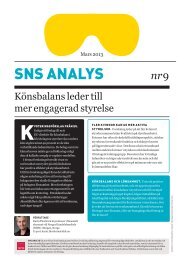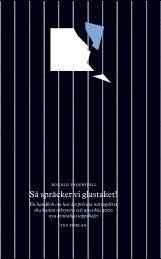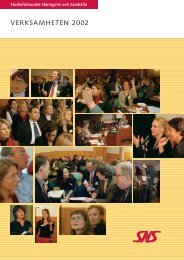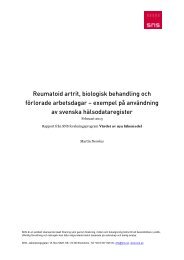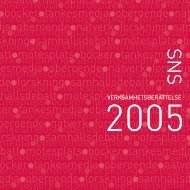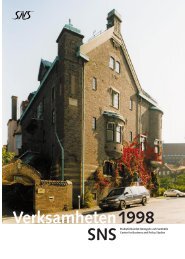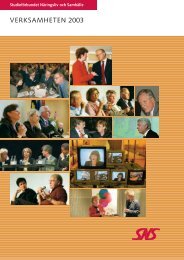Billie Pettersson and Frank R. Lichtenberg - SNS
Billie Pettersson and Frank R. Lichtenberg - SNS
Billie Pettersson and Frank R. Lichtenberg - SNS
Create successful ePaper yourself
Turn your PDF publications into a flip-book with our unique Google optimized e-Paper software.
3. Value of innovationIncreased longevity is an important part of economic growth <strong>and</strong> development, broadlydefined. In the OECD countries, life expectancy has increased by 10 years since 1960[28]. The enormous monetary value of increasing life expectancy has been noted instudies by Murphy <strong>and</strong> Topel [29]. The economic value of increases in longevity overthe twentieth century has been estimated by Nordhaus in a first approximation to beabout as large as the value of measured growth in non-health goods <strong>and</strong> services [30]<strong>and</strong> the increases in medical spending since 1960 in the USA were found to haveprovided reasonable value [1]. Based on Swedish data, estimates of the monetary valueof increasing life expectancy at birth during the period 1900-2000 suggest that the valueis about 5 million SEK per person <strong>and</strong> the value of the total increase in life expectancywas estimated to be about 75% of the increase in GDP during that period, about 1,552billion SEK [31].Medical innovation has had a major impact on both healthcare outcomes <strong>and</strong> the qualityof care but it may also have been a major driver of health care spending over the postwarperiod [32, 33]. Some studies have concluded that medical innovation has been themain reason for the rise in health care costs. However, some of these studies may nothave fully accounted for spillover across episodes of care or medical conditions. Forexample, a recent study of a cohort of US Medicare beneficiaries aged 65 years <strong>and</strong>older with a diagnosis of cataracts found that patients who had cataract surgery hadlower odds of hip fracture within one year after surgery compared with patients who hadnot undergone cataract surgery [34]. It was found that states that adopted new drugs <strong>and</strong>diagnostic imaging procedures more rapidly did not have larger increases in per capitamedical expenditure, controlling for other factors [35]. Also, <strong>Lichtenberg</strong> (2011) foundthat hospital procedure innovation increased survival of Western Australia hospitalpatients but had a negligible effect on their medical expenditure [36].3.1. Contribution of pharmaceutical innovation to longevity –evidence from SwedenIn this section we summarize the evidence based on data from Sweden on thecontribution of pharmaceutical innovation to longevity, <strong>and</strong> to decreasing use ofhospital days. We also investigate the pharmaceutical expenditures associated withpharmaceutical innovation <strong>and</strong>, finally, we use our estimates on effects <strong>and</strong> costs toestimate the cost effectiveness of pharmaceutical innovation. The entire paper isavailable as a working paper [37] <strong>and</strong> is accepted for publication in Economics ofInnovation <strong>and</strong> New Technology. We used longitudinal, disease-level data to analyzethe impact of pharmaceutical innovation on longevity <strong>and</strong> medical expenditure inSweden during the period 1997−2010. The measures of longevity we used are based onthe age distribution of deaths caused by a disease in a given year <strong>and</strong> in the increase inthe fraction of deaths that occurred at an age greater than 75.Pharmaceutical innovation can be measured in several different ways, because activesubstances are divided into different groups according to the organ or system on whichthey act <strong>and</strong> their therapeutic, pharmacological <strong>and</strong> chemical properties. In theAnatomical Therapeutic Chemical (ATC) classification system developed by the WorldHealth Organization Collaborating Centre for Drug Statistics Methodology, drugs areclassified in groups at five different levels. The highest (1 st ) level is the “anatomical15







